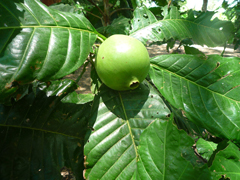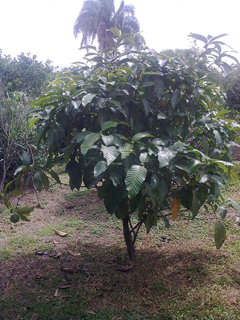 |
|
Jean-Luc Crucifix wikimedia.org |
 |
| Giovanny Garzon Pardo wikimedia.org |
Translate this page:
Summary
Borojo or Borojo patinoi is a small, tropical, evergreen shrub that grows up to 5 m high and is found in Northwestern South America. It is a dioecious species cultivated for its edible fruit that can be eaten raw or made into juice, jellies, preserves, etc. The fruit is also tonic and has many other medicinal uses.
Found In: Amazon, Central America, Colombia, Costa Rica, Ecuador, Nauru, Panama, South America.
Physical Characteristics

 Borojoa patinoi is an evergreen Tree growing to 8 m (26ft) by 6 m (19ft) at a medium rate.
Borojoa patinoi is an evergreen Tree growing to 8 m (26ft) by 6 m (19ft) at a medium rate.
See above for USDA hardiness. It is hardy to UK zone 10.
Suitable for: light (sandy), medium (loamy) and heavy (clay) soils, prefers well-drained soil and can grow in heavy clay soil. Suitable pH: mildly acid, neutral and basic (mildly alkaline) soils. It can grow in full shade (deep woodland) or semi-shade (light woodland). It prefers moist soil.
UK Hardiness Map
US Hardiness Map
Synonyms
Alibertia patinoi (Cuatrec.) Delprete & C.H.Perss.
Plant Habitats
Edible Uses
Edible Parts: Fruit
Edible Uses: Drink
Fruit - eaten raw or made into jellies, preserves, sauces, ice cream etc[ 301 ]. A sweet, aromatic flavour with some bitterness[ 335 ]. The green to brown fruit is 7 - 12 cm in diameter with a brown pulp that is very acid and dense[ 418 ]. The fruit pulp is used to prepare juice (jugo del amor), compotes, marmalades, candies and wine[ 418 ].
References More on Edible Uses
Medicinal Uses
Plants For A Future can not take any responsibility for any adverse effects from the use of plants. Always seek advice from a professional before using a plant medicinally.
Aphrodisiac
The fruit is prized for its tonic and cure-all qualities[ 418 ]. It is famous in western Colombia for its supposed aphrodisiac properties[ 418 ].
References More on Medicinal Uses
The Bookshop: Edible Plant Books
Our Latest books on Perennial Plants For Food Forests and Permaculture Gardens in paperback or digital formats.

Edible Tropical Plants
Food Forest Plants for Hotter Conditions: 250+ Plants For Tropical Food Forests & Permaculture Gardens.
More

Edible Temperate Plants
Plants for Your Food Forest: 500 Plants for Temperate Food Forests & Permaculture Gardens.
More

More Books
PFAF have eight books available in paperback and digital formats. Browse the shop for more information.
Shop Now
Other Uses
References More on Other Uses
Cultivation details
A plant of warm tropical lowlands usually at elevations up to 700 metres, but sometimes to 1,200 metres[ 418 ]. It grows best in areas where annual daytime temperatures fall within the range 20 - 28°c, though it can tolerate 15 - 32°c[ 418 ]. Temperatures in its native region may reach up to an absolute maximum of 41°c[ 418 ]. It prefers a mean annual rainfall in the range 3,000 - 6,000mm, tolerating 2,500 - 9,000mm[ 418 ]. It thrives with high air humidity average up to almost 90%[ 418 ]. Succeeds in heavy soils[ 335 ]. Prefers a pH in the range 4.5 - 6.5, tolerating 4 - 7[ 418 ]. The fruit takes more than one year to ripen after flowering. A dioecious species, both male and female forms need to be grown if fruit and seed are required[ 418 ].
References Carbon Farming Information and Carbon Sequestration Information
Temperature Converter
Type a value in the Celsius field to convert the value to Fahrenheit:
Fahrenheit:
The PFAF Bookshop
Plants For A Future have a number of books available in paperback and digital form. Book titles include Edible Plants, Edible Perennials, Edible Trees,Edible Shrubs, Woodland Gardening, and Temperate Food Forest Plants. Our new book is Food Forest Plants For Hotter Conditions (Tropical and Sub-Tropical).
Shop Now
Plant Propagation
Seed
Other Names
If available other names are mentioned here
Borojo or Borojo patinoi.
Native Range
SOUTHERN AMERICA: Costa Rica, Puntarenas, Panama, Darién, Panamá, Colombia, Cauca, Chocó, Ecuador, Esmeraldas, Pastaza,
Weed Potential
Right plant wrong place. We are currently updating this section.
Please note that a plant may be invasive in one area but may not in your area so it's worth checking.
None Known
Conservation Status
IUCN Red List of Threatened Plants Status : This taxon has not yet been assessed.

Growth: S = slow M = medium F = fast. Soil: L = light (sandy) M = medium H = heavy (clay). pH: A = acid N = neutral B = basic (alkaline). Shade: F = full shade S = semi-shade N = no shade. Moisture: D = dry M = Moist We = wet Wa = water.
Now available:
Food Forest Plants for Mediterranean Conditions
350+ Perennial Plants For Mediterranean and Drier Food Forests and Permaculture Gardens.
[Paperback and eBook]
This is the third in Plants For A Future's series of plant guides for food forests tailored to
specific climate zones. Following volumes on temperate and tropical ecosystems, this book focuses
on species suited to Mediterranean conditions—regions with hot, dry summers and cool, wet winters,
often facing the added challenge of climate change.
Read More
Expert comment
Author
Cuatrec.
Botanical References
Links / References
For a list of references used on this page please go here
A special thanks to Ken Fern for some of the information used on this page.
Readers comment
| Add a comment |
|
If you have important information about this plant that may help other users please add a comment or link below. Only comments or links that are felt to be directly relevant to a plant will be included. If you think a comment/link or information contained on this page is inaccurate or misleading we would welcome your feedback at [email protected]. If you have questions about a plant please use the Forum on this website as we do not have the resources to answer questions ourselves.
* Please note: the comments by website users are not necessarily those held by PFAF and may give misleading or inaccurate information.
To leave a comment please Register or login here All comments need to be approved so will not appear immediately.
|
Subject : Borojoa patinoi
|
|
|
|